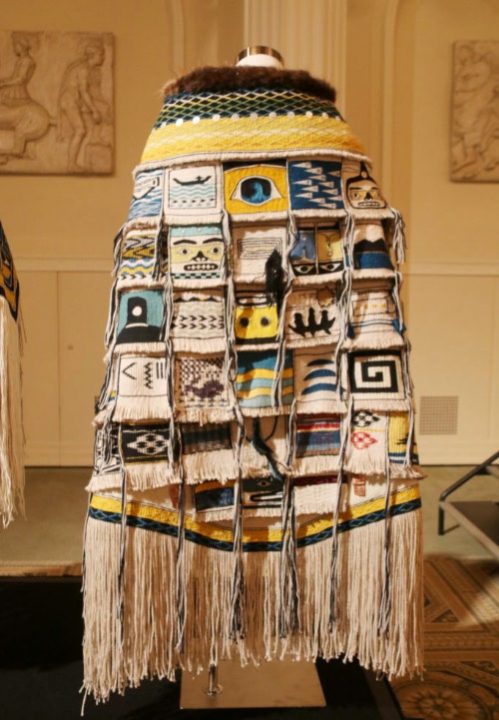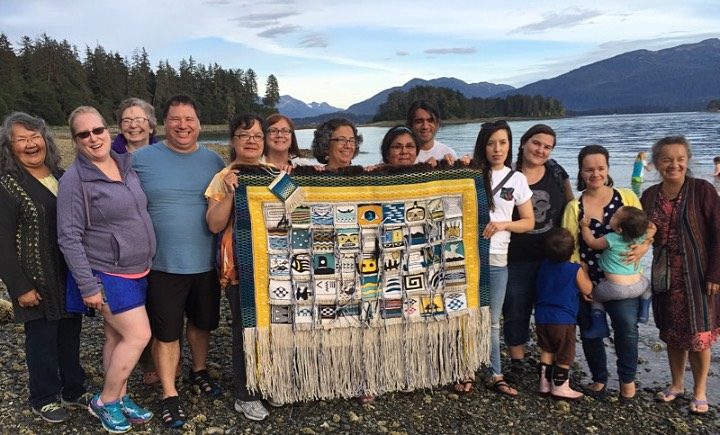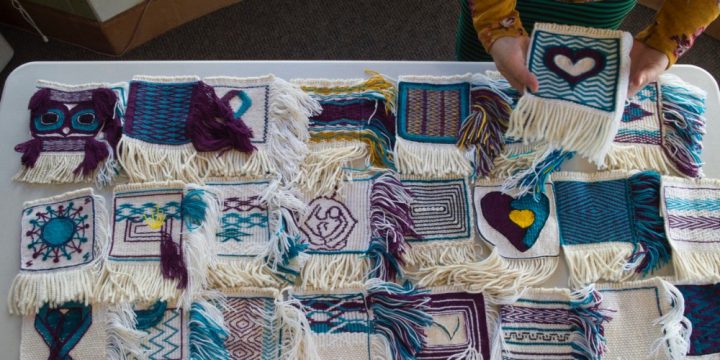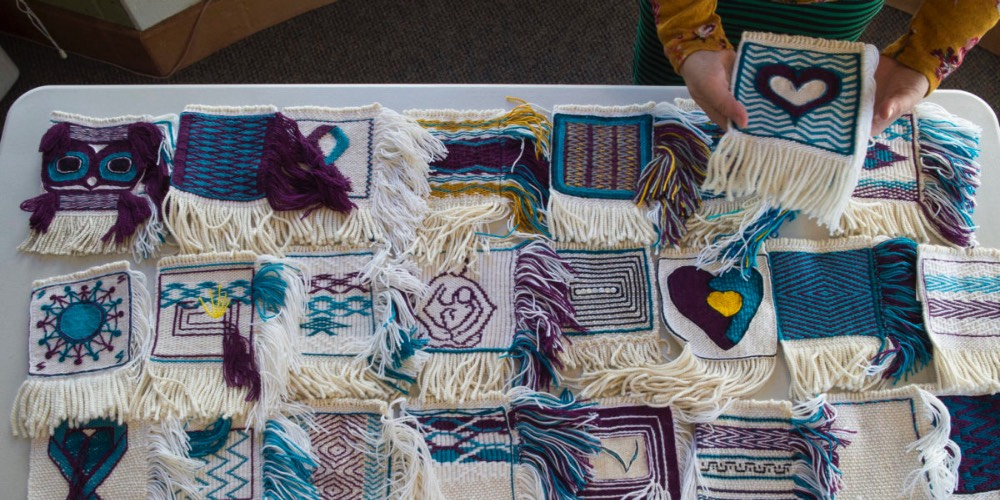Creating this together is motivated by the grief and survival many are feeling in regards to domestic violence in our women, our communities, and our nation. We weavers aim to come together to weave, to commune, and to bring strength to all involved…
—from the ‘Spirit Uprising’ website.
For over a year I tried to talk my sister out of organizing the creation of another collaborative Chilkat and Ravenstail robe.
Traditionally, a blanket-sized Chilkat or Ravenstail robe — a prized ceremonial item among the Native tribes of southeast Alaska and the northwest coast of Washington state and British Columbia — could be completed within about one year by an expert weaver, but a collaborative, granny quilt-like robe could theoretically be completed in much less time and with much less expertise, by a few dozen contributors. In 2016, my sister and I had watched (and helped) our mother Clarissa Rizal put in several months-worth of time, organizing and weaving the borders of collaborative ‘Weavers Across the Waters’ robe, which she promised us she’d never do again — or at least, not without pay.


But in September of last year, a woman named Heidi Vantrease posted a photo of a small white and purple weaving that she was working on — for Domestic Violence Awareness Month — in a weavers’ Facebook group, and suggested that someone do a purple collaborative robe similar to the Weavers Across the Waters.
When I saw the post I had my fingers crossed, hoping that one of the 50 people commenting would volunteer to organize the project before my sister did. They didn’t.
When my sister answered the phone, the first thing I said was, “Whatever you do, don’t do it.” After some long pauses and sighs, and really not-a-whole-lot of talking, we agreed that it had to be done.
The 400 year-old techniques of Chilkat and Ravenstail weaving originate in the Pacific Northwest region, where the topic of domestic and sexual violence feels very close to home for many. Running concurrently alongside the MeToo movement, the modern indigenous populations are raising awareness to the disproportionate rate of violence against native women compared to non-indigenous women.
Some unsettling data cited by IndianLaw.org:
“In the United States, violence against indigenous women has reached unprecedented levels on tribal lands and in Alaska Native villages. More than 4 in 5 American Indian and Alaska Native women have experienced violence, and more than 1 in 2 have experienced sexual violence. Alaska Native women continue to suffer the highest rate of forcible sexual assault and have reported rates of domestic violence up to 10 times higher than in the rest of the United States. Though available data is limited, the number of missing and murdered American Indian and Alaska Native women and the lack of a diligent and adequate federal response is extremely alarming to indigenous women, tribal governments, and communities. On some reservations, indigenous women are murdered at more than ten times the national average.”
Growing up around indigenous art, it was a simple fact that the ceremonial robes created by the people of the Pacific Northwest rainforest give much more than the eye might see. They are infused with energy. Similar to the idea of adorning a mask, when the weight of a wool robe is felt on one’s shoulders, and danced, the person wearing it is transformed to a certain extent. The healing spirit of the robe extends beyond itself.
With the state of current affairs, we agreed that this healing robe had to be made, and someone had to organize it.
Lily and I immediately began working out the logistics. Within 78 hours, weft yarn colors were picked out, preliminary contribution specifications were drafted, and we got started on a project budget. This time around, the robe project was going to pay for itself.
Within a couple weeks a website was published, the participant registration form launched, and contribution templates were drawn up. We had one sponsor, and participants were putting down deposits to secure their inclusion in the project.
We recruited our auntie Dee to help with project oversight and shipping, and several other volunteers offered their expertise. The project was growing beyond our expectations. Two months later, by December 1, over 80 participants were registered and had received weaving kits. Each weaving kit included a set of 4 weft yarn balls: 2 purple and 2 teal, so that all the squares would be tied together with the colors representing Domestic and Sexual Violence Awareness.

As weaving submissions started trickling in and participants began describing the stories behind their designs, I started thinking about what domestic violence means to me… how it has touched my life.
When I sat down to write my artist statement for this project, I came to my keyboard with the idea that I was in some way less worthy of participating and organizing this project, because I myself have not been physically abused. I started typing something like, “While I have not felt the direct impact of violence in my life…” which was then deleted and turned into, “As the effects of violence trickle down…” and then I realized that my reality has been distorted for quite a while now.
I had grown up with verbal, psychological, and physical violence as a constant in our house — in our passionate, compassionate, creative household, so rich in love. I normalized it. I compared it to the homes of my grandparents and my aunts and uncles and my friends… and then my own experiences didn’t seem so terrible. Instead of owning any emotional reaction, I’d just tuck all my own fear and heartache away, and there they continue to live: deep in the back of a storage closet that no longer sees the light… and I can feel them back there, but I can’t quite make out their shape.
Who will give us the space to talk about the terror that runs through our loving households? Who will tell us how deep the trauma goes? Who will judge the legitimacy of our experiences to make us feel worthy of grief?
As I watch my children grow — and I’ve been known to incite fear into their tiny little hearts with my soul-splitting growl — I know I cannot expect their worlds to be any more gentler than mine. I can only pray for their resilience, to know how to take their experiences and grow from each one.
But how do we foster resilience, if we do not talk about violence? If we are all just shoving our experiences into the shadows? How can we compare stories that are deeper and darker than any of us want to admit? How do we pull them up and handle them with tenderness?
Until we learn the answers to these questions, we unknowingly teach our children the clumsy art of hiding our trauma.
Last Thursday, the International Women’s Day, the Giving Strength Robe launched its fundraising campaign. This campaign has two parts:
- To help raise funds for the creation and archiving of this healing robe itself, and
- To further spread awareness of domestic and sexual violence.
Hundreds of hours and countless donated resources have already gone into this project. The more money is contributed, the more impact this project can have. Please help in any way you can. Thank you!
To donate, please visit www.CrowdRise.com/giving-strength
For more information, visit www.SpiritUprising.com

